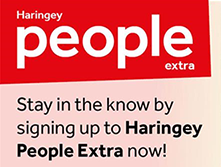Haringey Streets for People: Cabinet approves three low traffic neighbourhoods
Low traffic neighbourhoods will be introduced in Bounds Green, Bruce Grove West Green and St Ann’s to tackle pollution and support residents to walk, cycle and shop locally.
The three areas will be closed to through-traffic to help make them safer, greener and cleaner places for the people living there following the approval of the schemes at a Cabinet meeting last night (7 December 2021).
Each low traffic neighbourhood will see traffic filters introduced to stop rat running in local streets but allow pedestrians and cyclists to pass through. All homes and businesses will remain accessible by car, van and lorry.
Complementary measures agreed by Cabinet include secured cycle storage, new pedestrian crossings and additional school streets, which create a safe walk and cycle zone outside schools at drop-off and pick-up times.
The schemes are part of the ambitious Haringey Streets for People initiative and will play a key role in helping the council achieve its ambition of tackling the climate emergency and creating a zero-carbon borough by 2041.
They will also secure a green recovery from the pandemic and the benefits of the lockdown such as less traffic, cleaner air and higher levels of walking and cycling.
The on-street measures will be implemented under experimental traffic orders so that residents have an opportunity to feedback on how the measures work in practice before any decision is made on whether to make them permanent.
Cllr Mike Hakata, Deputy Leader and Cabinet Member for Environment, Transport and the Climate Emergency said: "This is the beginning of a truly transformative journey in which pedestrians, active travel and public transport are prioritised, especially on our neighbourhood roads. The low traffic neighbourhoods in our Streets for People programme reclaim local streets for the people living there, making them once more safe, welcoming, and liveable spaces where people meet, chat, socialise and where children play.
“They reduce pollution, speeding, road traffic collisions and carbon emissions, at the same time as improving the walkability and cyclability of the local area, creating active travel corridors between local amenities.
“We have learnt from the introduction of low traffic neighbourhoods elsewhere and undertaken a comprehensive engagement exercise, with the ideas and opinions fed into the design of each low traffic neighbourhood. We will continue to listen, as well as consider air quality and traffic data, before deciding whether to make the trials permanent.”
The council’s engagement exercise on low traffic neighbourhoods began in February 2021 with a survey to understand local issues and the improvements the community wanted introduced.
Residents, schools and businesses were also given the opportunity to comment on design options at workshops in May.
Starting in August, the council asked people to say what they think of the measures through a public consultation.
The low traffic neighbourhoods have been made possible thanks to a funding allocation from Transport for London, with the aim of delivering schemes that allow people to make more active and sustainable journeys.
Click here to read more.
Tell us what you think about this page
Problem with a service?
If you have a service problem or complaint you need help with then please visit our contact pages.
Help us improve this page
If you want to make comments specifically about this page, then please click the button below.
Haringey, Here to Help
See what help and support is available for residents

Haringey People Extra
e-newsletter


